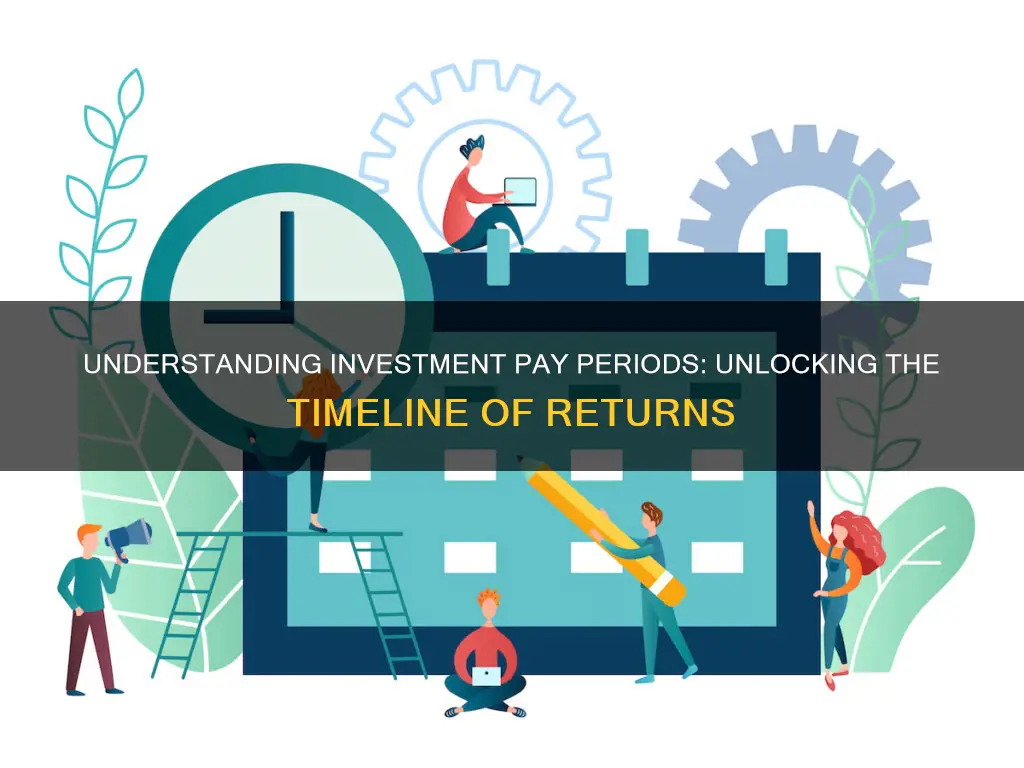
The payback period is a key consideration when making an investment. It refers to the amount of time it takes for an investment to pay for itself and break even. In other words, it's the length of time it takes for the revenue to equal the costs incurred. This is an important metric for investors, financial professionals, and corporations as it helps determine the risk and attractiveness of an investment. The payback period is calculated by dividing the initial investment by the average annual cash flow, with shorter paybacks generally considered more desirable.
| Characteristics | Values |
|---|---|
| Definition | The payback period is the amount of time it takes to recover the cost of an investment. |
| Other names | Break-even point |
| Formula | Cost of Investment ÷ Average Annual Cashflow = Payback Period |
| Calculation example | $15,000 (upfront investment) ÷ $1,500 (annual savings) = 10-year payback period |
| Factors | The shorter the payback period, the more attractive the investment. |
| Use cases | Used by investors, financial professionals, and corporations to calculate investment returns. Also used by businesses to calculate the rate of return on any new asset or technology upgrade. |
| Alternatives | Net Present Value (NPV), Internal Rate of Return (IRR), Discounted Cash Flow, and Discounted Payback Period. |
What You'll Learn

How to calculate the payback period
The payback period is the amount of time it takes to recover the initial cost of an investment, or to reach its break-even point. It is a quick and easy way to assess investment opportunities and risk.
The payback period is calculated by dividing the initial investment by the annual cash flow. This can be done using the averaging method or the subtraction method.
Using the averaging method, the initial amount of the investment is divided by the annual cash flows the investment is projected to generate. This works well if cash flows are predictable or expected to be consistent over time.
For example, if a company invests $1,000,000 in new equipment that is expected to generate $250,000 in revenue per year, the calculation would be:
$1,000,000 / $250,000 = 4-year payback period
Using the subtraction method, you start by subtracting individual annual cash flows from the initial investment amount, and then do the division. This method works better if cash flows vary from year to year.
For example, a company is considering making a $550,000 investment in new equipment. The expected cash flows are as follows:
- Year 1 = $75,000
- Year 2 = $140,000
- Year 3 = $200,000
- Year 4 = $110,000
- Year 5 = $60,000
Year 0: -$550,000
Year 1: -$475,000
Year 2: -$335,000
Year 3: -$135,000
Year 4: -$25,000
Year 5: $35,000
Year 4 is the last year with negative cash flow, so the payback period equation is:
4 + ($25,000 / $60,000) = 4.42
So the payback period is 4.42 years.
The payback period is a useful tool for evaluating investments, but it has some limitations. It does not take into account the time value of money or the riskiness of the project. It also does not show the specific profitability of the investment. Therefore, it is important to use the payback period in conjunction with other metrics for a more thorough analysis of investment opportunities.
Severance Windfall: Investing for the Future
You may want to see also

The pros and cons of payback period analysis
The payback period is a popular method for evaluating the profitability of an investment project. It is calculated by dividing the initial investment by the annual cash inflow. This method is especially useful for small businesses with limited resources, as it helps them quickly recoup their costs and reinvest in other opportunities.
Pros of Payback Period Analysis:
- Simplicity: The concept is simple to understand and calculate, even without a calculator or spreadsheet.
- Risk Focus: It focuses on how quickly money can be returned from an investment, which is a measure of risk.
- Liquidity Focus: It favours projects that return money quickly, resulting in investments with higher short-term liquidity. This is particularly useful when long-term returns are uncertain due to economic instability or entering new markets.
- Useful for Small Businesses: It is a great way for small businesses with limited funds to decide which projects will pay off the most and quickly recoup their costs.
- Useful in Uncertain Situations: It is valuable in sectors with high uncertainty or rapid technological changes, where it is challenging to forecast future annual cash inflows.
- Faster Reinvestment of Earnings: This method helps businesses that want to recover their capital for reinvestment and growth identify investments that will provide the fastest returns.
- Ensures Financial Liquidity: It helps businesses maintain liquid funds for daily operations and future investments.
- Quick Decision-Making: It is easy to compute and requires fewer inputs, enabling managers to make quick decisions, which is crucial for businesses with limited resources.
- Prevents Major Losses: It helps small and medium-sized businesses identify lower-risk investments with shorter break-even times, reducing the risk of significant losses.
- Manages Multiple Choices: It provides a basic understanding of how different projects rank, helping managers choose the most suitable ones when faced with multiple proposals.
Cons of Payback Period Analysis:
- Ignores Time Value of Money: It disregards the concept that money received sooner has a higher value than money received later due to its potential for reinvestment and higher returns.
- Ignores Profitability: It focuses on liquidity and quick investment recovery, ignoring the profitability of a project beyond the breakeven point.
- Ignores Cash Flow After Payback: It only considers cash flows until the initial investment is recovered, potentially overlooking projects that could generate higher cash flows in later years.
- Simplistic: Its simplicity may overlook normal business conditions, such as ongoing capital investments and irregular cash inflows.
- Does Not Evaluate Investments Appropriately: It focuses on short-term cash flow, biasing evaluations towards maximising short-term profits rather than considering longer-term cash flow.
Microsoft: Invest Now or Miss Out?
You may want to see also

How the payback period compares to other methods
The payback period is a useful metric for investors, financial professionals, and corporations to assess the viability of an investment. It is calculated by dividing the initial investment by the average annual cash flow, and it helps determine how long it will take to recover the initial costs.
While the payback period is a valuable tool, it has some limitations when compared to other methods, such as net present value (NPV) and internal rate of return (IRR). Here's how the payback period compares to these other methods:
- Net Present Value (NPV): NPV is a more comprehensive evaluation method that considers the time value of money (TVM). It calculates the difference between the present value of cash inflows and outflows over a period. Unlike the payback period, NPV accounts for the earning potential of money today versus the same amount in the future. This is important because $15,000 received in five years is likely worth less than $15,000 today due to depreciation and lost earning potential. NPV also considers the overall profitability of a project, taking into account cash inflows beyond the payback period. This is a significant advantage over the payback period, which only focuses on the initial investment recovery.
- Internal Rate of Return (IRR): IRR is another popular method that addresses some of the payback period's limitations. IRR calculates the discount rate that sets the net present value of a project to zero. While IRR does not consider risk, it can be used alongside the payback period to make more informed investment decisions. IRR provides a more nuanced understanding of an investment's potential returns, while the payback period offers a quick assessment of risk and liquidity.
- Discounted Payback Period: The discounted payback period is an alternative to the traditional payback period that incorporates the time value of money. This method adjusts cash inflows to account for the fact that money received in the future is worth less than money received today. By adding time value into the equation, the discounted payback period provides a more accurate assessment of an investment's viability.
In summary, the payback period is favoured for its simplicity and ease of calculation. However, when compared to methods like NPV, IRR, and the discounted payback period, it falls short in several ways. It fails to consider the time value of money, the overall profitability of a project, and other risk factors. Therefore, it is often used as a preliminary evaluation tool, supplemented by more comprehensive analyses like NPV and IRR, to make well-informed investment decisions.
Stock Market: Why Don't More People Invest?
You may want to see also

The drawbacks of using the payback period
The payback period is a common method for businesses to determine the viability of an investment. It is a simple calculation that divides the initial investment by the estimated annual cash flow to determine the number of years it will take to recoup the investment. While this method is popular due to its simplicity, there are several drawbacks to using the payback period in capital budgeting and investment decisions.
Short-Term Focus
One of the main drawbacks of the payback period method is its short-term focus. It only considers the initial return on investment and does not take into account the long-term potential of an investment. This can be problematic as not all investments are intended to provide quick returns, and some may have greater potential over a longer period.
Ignores Time Value of Money
The payback period analysis fails to take into account the time value of money (TVM). TVM is the concept that money received today is worth more than the same amount in the future due to its potential to generate returns through reinvestment. By ignoring TVM, the payback period method treats a dollar received today as equal to a dollar received several years from now, which can distort the true value of cash flows.
Neglects Cash Flows After Payback Period
The payback period method only considers cash flows until the initial investment is recovered and ignores any cash flows that occur after the payback period. This can be misleading as some projects may have higher returns on investment in the later years, which would be overlooked in favour of projects with shorter payback periods.
Does Not Consider Profitability
A short payback period does not necessarily indicate that a project is profitable. The cash flows may decrease or stop altogether after the payback period, rendering the project unviable. Therefore, the payback period method fails to provide a complete picture of a project's profitability and overall financial performance.
Does Not Consider Return on Investment
Some companies require capital investments to meet a certain rate of return, or else the project is declined. The payback period method does not consider the rate of return and can, therefore, lead to the acceptance of projects that do not meet the desired return on investment.
In conclusion, while the payback period method has its advantages in terms of simplicity and ease of calculation, it has several drawbacks that can impact investment decisions. It is important for businesses to be aware of these limitations and consider using additional evaluation methods, such as net present value (NPV) analysis or internal rate of return (IRR), to make more informed and comprehensive investment decisions.
Dividend Dilemma: Exploring the Intricacies of Payouts and Investments
You may want to see also

How the payback period is used in capital budgeting
The payback period is a fundamental concept in capital budgeting, and it is perhaps the simplest method for evaluating the feasibility of a potential investment or project. It refers to the time required to recoup the funds expended on an investment or to reach the break-even point. In other words, it is the length of time an investment takes to become profitable.
The payback period is calculated by dividing the initial investment by the average annual cash flow. For example, if a project has an initial investment of $1 million and is expected to generate annual cash flows of $250,000, the payback period would be four years.
The payback period is a useful tool for capital budgeting because it allows firms to compare alternative investment opportunities and decide on projects that offer the quickest return on investment. This is particularly important when liquidity is a major concern, as companies may only be able to undertake one major project at a time. In such cases, management will prioritise recovering their initial investment to be able to move on to subsequent projects.
However, the payback period has some limitations. Firstly, it does not account for the time value of money, which suggests that a dollar today is worth more than a dollar tomorrow due to its earning potential. This can be rectified by using a discounted payback period model, which takes into account the discounted cash flow. Secondly, the payback period ignores cash flows that occur towards the end of a project's life, such as salvage value, and therefore does not provide a direct measure of profitability. Finally, it does not explicitly discount for the risk and opportunity costs associated with a project.
Despite these drawbacks, the payback period is often used as an initial analysis tool because it is easy to calculate and understand, even for those without a financial background. It is often used in conjunction with other methods, such as the internal rate of return (IRR) or net present value (NPV), to make more informed investment decisions.
SPACs: The New Investment Craze
You may want to see also
Frequently asked questions
The payback period is the amount of time it takes for an investment to pay for itself and break even. It is calculated by dividing the initial investment by the average annual cash flow. The formula is: Cost of Investment / Average Annual Cash Flow = Payback Period.
The payback period is important as it helps investors, financial professionals, and corporations assess the risk and potential return on an investment. It is a simple calculation that provides a quick overview of how long it will take to recover the initial investment.
The payback period is one of several factors considered when making investment decisions. Generally, a shorter payback period is more attractive and desirable as it indicates lower risk and quicker recovery of the initial investment. However, it is not the only factor, as other considerations may include the overall profitability and long-term potential of an investment.
The payback period has some drawbacks. It does not account for the time value of money, the effects of inflation, or the complexity of investments with unequal cash flow over time. It also does not provide information on the specific profitability of an investment, only the time it takes to break even. Therefore, it is often used in conjunction with other analysis tools, such as the net present value (NPV) or internal rate of return (IRR).







